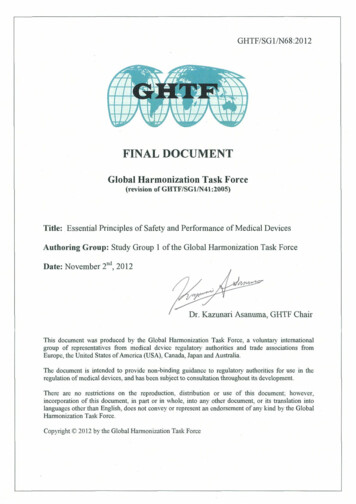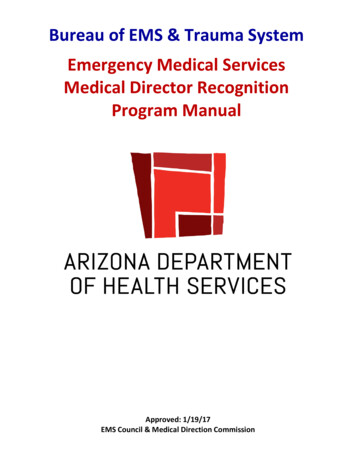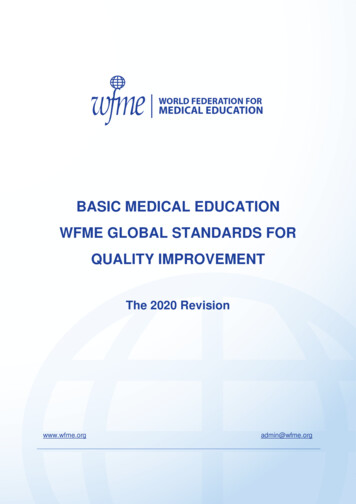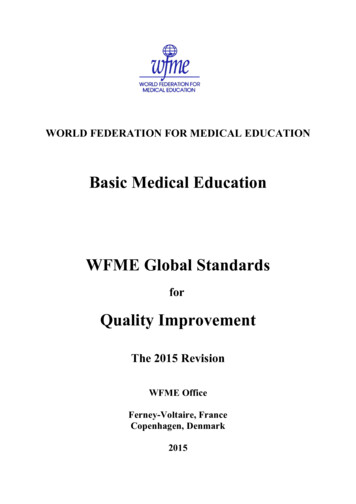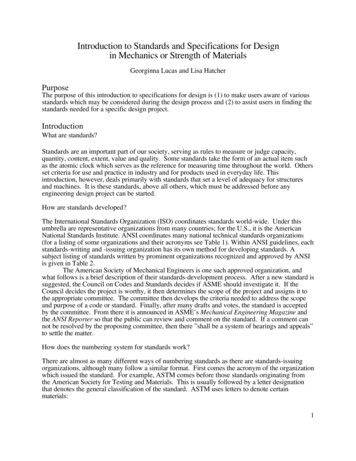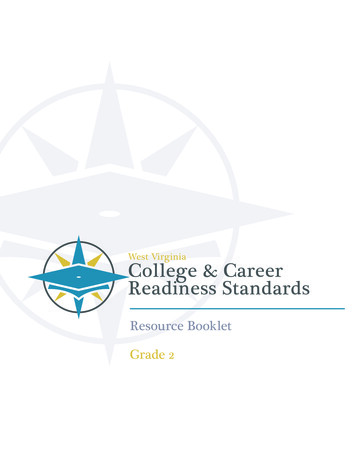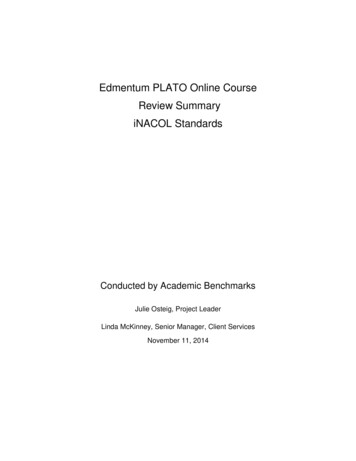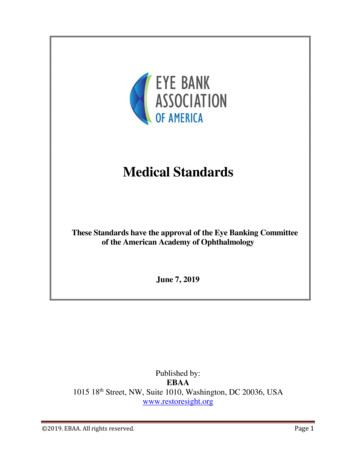
Transcription
Medical StandardsThese Standards have the approval of the Eye Banking Committeeof the American Academy of OphthalmologyJune 7, 2019Published by:EBAAth1015 18 Street, NW, Suite 1010, Washington, DC 20036, USAwww.restoresight.org 2019. EBAA. All rights reserved.Page 1
EBAA Medical Standards – June 2019Table of ContentsA1.000 Introduction and Purpose .5A1.100 Scope .5B1.000 Active Membership .5B1.100 Eye Bank Inspection.6B1.200 Inspections by Official Agencies .6C1.000 Personnel and Governance.6C1.100 Director.6C1.200 Medical Director .7C1.300 Staff Performing Eye Banking Functions .8C1.400 Change in Governance .9C2.000 Training, Certification and Competency Reviews of Personnel Performing TasksOverseen and/or Regulated by the EBAA, FDA, and Other State Federal Agencies .9C3.000 Facilities .9C3.100 Eye Bank Laboratory .10C3.200 Equipment, Maintenance and Cleaning .10C3.300 Instruments and Reagents.11C3.400 Procedures Manual .11C3.500 Other Establishments Performing Eye Banking Functions .11C3.510Eye Bank Functions Performed by Another Establishment .12C3.600 Infection Control and Personnel Safety .12C3.700 Biohazardous Waste Disposal .13D1.000 Donor Eligibility Determination .13D1.100 Donor Screening .14D1.110 EBAA Specific Contraindications to Transplant .14D1.120 Screening for FDA Defined Relevant Communicable Disease Agentsand Diseases .15D1.200 Donor Testing .15D1.210 EBAA Testing Requirements.16D1.220 FDA Testing Requirements .16 2019. EBAA. All rights reserved.2
EBAA Medical Standards – June 2019D1.230 Non-Required Testing Results .16D1.300 Documentation of Donor Information .17D1.400 Method and Authorization for Donation .17D1.500 Donor Age .17D1.600 Interval between Death, Enucleation, Excision, Preservation and Processing .17D1.700 Eye Maintenance Prior to Recovery .17D1.800 Living Donors .18E1.000 Recovery, Processing, and Preservation .18E1.100 Recovery .18E1.200 Processing and Preservation .19E1.210 Whole Eye .19E1.220 Cornea.19E1.221 Processing via Excision of the Corneoscleral Disc from EnucleatedWhole Eyes .20E1.222 Lamellar Tissue Processing .20E1.223 Laser Assisted Processing .20E1.230 Sclera .20E1.300 Use of Short or Intermediate Term Storage Solution .20E1.400 Long Term Preservation and Organ Culture .20F1.000 Tissue Evaluation .20F1.100 Slit Lamp Examination .21F1.200 Endothelial Cell Density and Pachymetry .22F1.300 Determination of Surgical Suitability .22G1.000 Quality Assurance .24G1.000 Quality Control .25G1.200 Microbiologic Culturing .25G1.300 Tissue Recall or Tissue Withdrawal .26H1.000 Non-Surgical Donor Tissue .26I1.000Storage .27I1.100 Expiration Dating .27 2019. EBAA. All rights reserved.3
EBAA Medical Standards – June 2019J1.000 Labeling .27K1.000 Distribution of Tissue .28K1.100 Review of Donor Medical Information.28K1.200 Distribution Compliance .28K1.300 Fair and Equitable System .28K1.400 Returned Tissue.28K1.500 Fraudulent Activity .29L1.000 Documentation to Accompany Donor Tissue .29L1.100 Tissue Report Form .29L1.200 Package Insert Form .31L2.000 Packaging, Sealing and Packing for Transport .32M1.000 Eye Bank Records .32M1.100 Length of Storage .32M1.200 Confidentiality .32M1.300 Donor Screening Forms .32M1.400 Minimum Information to Be Retained .32M1.500 Recipient Follow-up Information .33M1.600 Statistical Reporting .34N1.000 Amendments .35Glossary (Definitions of Terms) .36 2019. EBAA. All rights reserved.4
EBAA Medical Standards – June 2019EBAA MEDICAL STANDARDSA1.000 Introduction and PurposeThese standards have been developed to assure consistently acceptable levels ofquality, proficiency, and ethics in dealing with ocular tissue for transplantation anddefine the minimum standards of practice for eye bank functions, as determined by theophthalmological medical community.A1.100 ScopeThese standards are intended to apply to any and all of the eye bank functions,to include: RecoveryProcessingStorageTissue evaluationDonor eligibility determinationDistributionThese standards shall be reviewed at least annually and revised as necessary toincorporate current research findings and improved clinical practice.B1.000 Active MembershipIn order for an eye bank to become an active member of the Eye Bank Association ofAmerica (EBAA), it must comply with the EBAA Bylaws and the following:1. Demonstrate compliance with EBAA Medical Standards.2. Maintain accreditation status by passing the site inspection as administered bythe EBAA Accreditation Board.3. Demonstrate proficiency in any aspect of eye banking including recovery,processing, tissue storage, evaluation, donor eligibility determination anddistribution.4. Proficiency shall be demonstrated by providing documentation, at the time ofcompleting the application, of the handling of at least 25 surgical corneas foreach eye bank function for which it is seeking accreditation.5. Certify compliance with applicable Federal and State regulations.6. Maintain registration with ICCBBA for a Facility Identification Number (FIN).This is required for all eye banks that assign a DIN or apply an ISBT 128 labelto ocular tissue.Once accredited, an eye bank must be inspected and reaccredited at least every threeyears to maintain active membership in the EBAA. 2019. EBAA. All rights reserved.5
EBAA Medical Standards – June 2019B1.100 Eye Bank InspectionThe Accreditation Board of the EBAA shall be responsible for inspectingmember eye banks as outlined in the written procedures of the Board.Accreditation and reaccreditation site inspections shall be scheduled followingwritten notification of the impending inspection. Unannounced inspectionsmay be conducted should an allegation of violation of Medical Standards bemade to the Accreditation Board, or should the results of inspections byofficial agencies indicate violation of Medical Standards. Failure to permit aninspection will result in suspension or revocation of an eye bank’saccreditation.Demonstration of proficiency in any and all aspects of eye banking may berequired during the site inspection and of any or all technical personnel. TheAccreditation Board may review and make a determination to accept findingsfrom outside agencies. (Please refer to Accreditation Policies and Procedures.)B1.200 Inspections by Official AgenciesAny written documentation of notices of inspection, observations, findings, orresults (including but not limited to Food and Drug Administration (FDA)Form 483) received by an eye bank which are related to any inspection by anofficial agency shall be sent to the EBAA office within ten (10) business daysof receipt. The EBAA office shall be copied on all future relatedcorrespondence.C1.000 Personnel and GovernanceC1.100 DirectorAll policies and procedures of each eye bank shall be under the supervision ofa Director appointed by the eye bank’s Board of Directors, Board of Regentsor other governing body. The Director shall be responsible for alladministrative operations including compliance with these standards.The Director shall be the individual responsible for the day-to-day operationof the eye bank. It is this individual’s responsibility to carry out policies ofthe eye bank’s Board, to determine what functions will be performed by theeye bank, and to prescribe clinically acceptable means to perform thesefunctions.The Director shall consult with the Medical Director, as well as other medicaland legal authorities, in carrying out prescribed responsibilities as necessary.These consultations shall be documented and made available for reviewduring a site inspection. 2019. EBAA. All rights reserved.6
EBAA Medical Standards – June 2019The Director shall provide all staff members with adequate information toperform their duties safely and competently. Delegation of responsibility forthe clinical work of the eye bank shall be as follows:C1.200 Medical DirectorThe eye bank must have a Medical Director. When the Medical Director isnot available, a back-up Medical Director shall be designated who is capableof fulfilling the responsibilities of the Medical Director on an interim basis.The Medical Director and a back-up Medical Director must be anophthalmologist who has completed a corneal fellowship or who hasdemonstrated expertise in external eye disease, corneal surgery, research orteaching in cornea and/or external disease. If the Medical Director has notserved a corneal fellowship, then the eye bank must have and document aconsulting relationship with an ophthalmologist who has.Any physician who provides verification of competency for tissue recoveryand preservations shall attend the Medical Directors’ Symposium at theannual meeting of the EBAA at least once every three years and a MedicalAdvisory Board meeting once every three years. A newly appointed MedicalDirector shall attend a Medical Directors’ Symposium and a MedicalAdvisory Board Meeting within one year of appointment, unless a CoMedical Director has fulfilled the requirement. The eye bank shall providewritten documentation of such attendance at the time of the eye bank siteinspection.The Medical Director shall oversee and provide advice on all medical aspectsof the eye bank operations. These include but are not limited to:1. Formulation, approval, and implementation of medical policies andprocedures.2. Participation in training and oversight of technical staff with regard toeye bank functions.3. Participation in establishment and operation of a quality assuranceprogram.4. Responsibility for verification of competency for tissue recovery andpreservation by personnel applying for CEBT certificationAn eye bank’s Medical Director must observe the designated staff trainer ortrainers performing the following procedures as applicable on an annual basis:1. In-situ corneoscleral disc excision or laboratory corneoscleral discremoval from whole eye2. Posterior lamellar processing procedure that utilizes a microkeratome3. At least one type of laser-shaped processing procedure 2019. EBAA. All rights reserved.7
EBAA Medical Standards – June 20194. Each manual dissection processing procedure(s) for EK and ALK (i.e.DSEK or DMEK)If an eye bank Medical Director has not designated any individuals as stafftrainers, he/she must observe each technician they have qualified to performany of the above procedures on an annual basis.The Medical Director may delegate responsibility for eye bank functions toqualified eye bank personnel; however, the Medical Director shall ensure thatthe eye bank operates in compliance with the EBAA Medical Standards.Ultimate responsibility for the suitability of each tissue for the transplantationin patients rests with the transplanting eye surgeon.An eye bank has three months to replace a Medical Director who has resigned.C1.300 Staff Performing Eye Banking Functions.The Director shall appoint technical and supportive staff and ensure that thisstaff has the appropriate qualifications and training for the performance oftheir job responsibilities. The Director shall ensure that there are a sufficientnumber of qualified eye bank technicians and supportive staff to perform alleye bank laboratory tests and procedures at a level of proficiency establishedby the bank. The eye bank Medical Director or Medical Director’s designeemust document in writing those eye bank tasks in which each staff member isqualified and released to perform independently.Each eye bank must employ at least one EBAA CEBT in a supervisory andtraining role(s).If the only function the establishment performs is recovery and/or storage, adocumented contractual, consultative relationship with a CEBT and theaccredited organization in which the CEBT is employed may be an acceptablealternative to having a CEBT on staff.An eye bank or other establishment which performs eye banking functions hassix months in which to replace their required EBAA CEBT(s) provided that:1. The establishment notifies the EBAA office in writing that it does notmeet this standard.2. The establishment submits appropriate evidence of its intent to complywith the “required CEBT” standard.3. A documented interim consultative relationship is established with aCEBT and the accredited organization in which the CEBT isemployed.4. The non-CEBT technician in charge in the interim has demonstratedcompetency to the Medical Director of the involved establishment. 2019. EBAA. All rights reserved.8
EBAA Medical Standards – June 2019If a six-month deadline cannot be met, the establishment may request anextension by writing to the EBAA office. An extension may be granted on acase-by-case basis after review by the Chair of the Accreditation Board, inconsultation with the EBAA CEO or designee.C1.400 Change in GovernanceAn eye bank that undergoes a change in governance must notify the EBAAoffice (in writing) within 30 days. Changes in governance include merger ofeye banks, affiliation of two or more eye banks, affiliation of an eye bank withanother non-eye bank organization (e.g. tissue banks, organ procurementorganizations, hospitals, blood banks, etc.), a change in the name of the eyebank, or a change in required personnel, i.e. Director, Medical Director.(Please refer to Accreditation Policies and Procedures E1.500.)C2.000 Training, Certification and Competency Reviews of Personnel Performing TasksOverseen and/or Regulated by the EBAA, FDA, and Other State and FederalAgencies.An eye bank or other establishment performing eye banking functions must provide aformal orientation program for each new employee and the employee’s participationmust be documented.An eye bank or other establishment performing eye banking functions, must alsoestablish a comprehensive and well-defined training program outlining specific jobrelated tasks that each employee is being trained to perform. This training programshall contain documentation indicating when each employee is released to perform theirjob-related tasks independently. This comprehensive training program shall include theimplementation and documentation of annual competency reviews of the skills and jobrelated knowledge of all eye bank employees performing eye banking functions. Theperson responsible for these competency reviews must be a CEBT or an individual whohas been qualified by a CEBT who is part of the organization’s comprehensive qualityprogram.Eye bank technicians seeking to receive EBAA certification or become re-certifiedmust meet the criteria set forth in the EBAA document Criteria for Certification andRecertification of Eye Bank Technicians.All EBAA accredited eye banks must have one CEBT attend an EBAA sponsored skillsworkshop once every three years.C3.000 FacilitiesEach establishment performing any eye bank function listed in Medical StandardA1.100 (Scope), must have sufficient space, equipment and supplies to accommodate 2019. EBAA. All rights reserved.9
EBAA Medical Standards – June 2019the volume of services performed with optimal accuracy, efficiency, sterility, timelinessand safety. The EBAA office shall be notified (in writing) within 30 days of therelocation, laboratory expansion or addition of a satellite to an eye bank. (Please refer toAccreditation Policies and Procedures E1.400.)C3.100 Eye Bank LaboratoryThe laboratory must be a separate area with limited access in which activitiesdirectly related to eye banking are carried out. The laboratory shall have asink with a drain and running water. There must be adequate counter spacefor preparation of donor material. The room including walls, floor and sinkmust be kept clean at all times. Appropriate documentation of regularlaboratory cleaning schedules must be maintained and kept on file for aminimum of three years.Each eye bank laboratory must have an adequate stable electrical source and asufficient number of grounded outlets for operating laboratory equipment.C3.200 Equipment, Maintenance and CleaningEach eye bank laboratory shall have a refrigerator with a device, visiblewithout opening the refrigerator, for recording temperature variations. Thetemperature recording device should reflect the temperature of the storedtissue under normal storage conditions. Temperature variations must berecorded daily and remain within the range of 2 to 8o Celsius. Therefrigerator’s continuous temperature recorder must be calibrated against anNIST standard thermometer (or for eye banks outside the U.S.A., a standardthermometer as defined by their countries’ regulatory agencies) at least once ayear. The refrigerator shall be maintained for the use of tissue and tissuepreservation solution and must contain clearly defined and labeled areas forall tissue stored, i.e., quarantined tissue, surgical tissue awaiting distribution,and research tissue. Eye banks must detail required refrigerator cleaningintervals and documentation in their Policies and Procedures manual.In the event of a temperature deviation outside the acceptable range, theremust be provision for immediate notification and action to be taken. Testingof the alarm system must be performed and documented on a regular basis.The eye bank laminar airflow cabinet or flow hood must be cleaned beforeand after each use and at regularly scheduled intervals to prevent crosscontamination.Appropriate maintenance and qualification and/or certification records mustbe maintained on each piece of equipment. These records must show dates ofinspection, performance evaluations and any maintenance procedures orrepairs performed. 2019. EBAA. All rights reserved.10
EBAA Medical Standards – June 2019The eye bank must include in its procedures manual, the monitoring,inspection and cleaning procedures and schedules for each piece of equipmentand laboratory area. Documented cleaning schedules for laboratoryequipment must be kept on file for a minimum of three years.C3.300 Instruments and ReagentsAdequate instrumentation must be available to provide for sterile removal andprocessing of whole eyes and corneas. Instruments must be inspectedfrequently enough to assure that they function properly. An eye bank thatuses an autoclave to sterilize its instruments shall adhere to the maintenanceprocedures for autoclaves as recommended in the current Association for theAdvancement of Medical Instrumentation (ANSI/AAMI) Standard 79 –“Comprehensive guide to steam sterilization and sterility assurance in healthcare facilities”. The eye bank must outline these steps in its procedure manual.Certification to validate temperature, pressure and time shall be performedand documented according to manufacturer’s recommendation or annually ifnot defined by manufacturer. If instruments are sterilized outside of the eyebank, the eye bank shall provide documentation of appropriate sterilization.All sterilized instruments, supplies and reagents, such as corneal storagesolution, must contain sterilization dates, method or appropriate expirationdates that are current at all times if applicable.C3.400 Procedures ManualEach eye bank shall maintain its own policies and procedures manual thatdetails all aspects of its specific eye bank functions, and quality assurancepractices. Each procedure must be initially approved, signed, and dated by theDirector and Medical Director. An annual review of each eye bank’sprocedure with signing and dating by the Director and Medical Director isrequired. Each eye bank must maintain copies of each procedure it uses andthe length of time the procedure was in use. Procedures must be readilyavailable to personnel in the area where operations are performed.Eye banks shall utilize ICCBBA Eye Bank Technical Advisory Group(EBTAG) nomenclature to describe ocular tissue classes and attributes,effective June 30, 2015.C3.500 Other Establishments Performing Eye Banking FunctionsAny establishment performing eye bank functions must employ a CEBT. Arecovery and/or a storage-only establishment may meet this requirement byhaving a documented consultative relationship with a CEBT and the EBAAaccredited organization in which the CEBT is employed. 2019. EBAA. All rights reserved.11
EBAA Medical Standards – June 2019All establishments performing specialized or specific eye banking functionsmust have a Medical Director or access to a Medical Director through adocumented consultative relationship with an EBAA accredited organization.This Medical Director must meet the requirements of Medical Director asoutlined in section C1.200 of these standards. Establishments performingspecific eye banking functions may be inspected as part of the EBAAaccreditation process of an organization in which they provide services.C3.510 Eye Bank Functions Performed by Another EstablishmentAny EBAA accredited organization engaging with anotherestablishment that performs eye banking functions prior todistribution must either:1. Document that the establishment is currently EBAAaccredited for the eye bank functions performed; or2. Document that the establishment is in compliance with EBAAmedical standards, state and federal regulations appropriate to theeye bank functions performed. This option requires a writtenagreement and the EBAA accredited organization is responsiblefor performing compliance audits. Policies and procedures shalldescribe the audit plan, scope, and frequency.C3.600 Infection Control and Personnel SafetyWritten safety procedures for the eye bank operation shall be established incompliance with the Occupational Safety and Health Act (OSHA Act) of 1970and the 1991 amendments to Part 1910 of title 29 of the Code of FederalRegulations), Subpart Z and/or applicable state statutes, which may supersede.For eye banks where OSHA regulations do not apply, written safetyprocedures in compliance with the relevant regulatory agencies are anacceptable substitute. All eye bank personnel performing functions whichmay cause exposure to human body fluids or tissue must operate under thecurrent Standard Precautions for health care workers issued by the CDC ofHHS. 1 These written procedures must be included in the eye bank’sprocedure manual.1On December 6, 1991, the Occupational Safety and Health Administration (OSHA) of the U.S. Department ofLabor (DOL) published its final rules regulating worker occupational exposure to bloodborne pathogens, includingbut not limited to hepatitis B virus (HBV) and human immunodeficiency virus (HIV). These regulations went intoeffect March 6, 1992 and make employers responsible for providing and ensuring safe working conditions in allwork settings. See the December 6, 1991, Federal Register, Vol. 56, no. 235. 2019. EBAA. All rights reserved.12
EBAA Medical Standards – June 2019C3.700 Biohazardous Waste DisposalHuman tissue and waste items shall be disposed of in such a manner as tominimize any hazard to eye bank personnel and the environment and tocomply with state and federal regulations. Dignified and proper disposalprocedures shall be used to obviate recognizable human remains and must bedocumented.D1.000 Donor Eligibility DeterminationBefore tissue is made available for distribution, the Donor Eligibility Determinationmust be made by a responsible person. Reference Appendix II for requirements relatedto the donor eligibility process. Eye banks outside of the United States should referenceAppendix V for requirements related to the donor eligibility process.Prior to making an eligibility determination, the donor must be screened according toD1.200. In addition to donor eligibility determination, tissue must be evaluated forsuitability per F1.000.All donors must be identified by name. All prospective donors shall undergo a physicalexamination as close as possible to the donation with special attention to physical signsof HIV disease, infectious hepatitis, and injecting drug use. Each eye ban
ophthalmologist who has completed a corneal fellowship or who has demonstrated expertise in external eye disease, corneal surgery, research or teaching in cornea and/or external disease. If the Medical Director has not served a corneal fellowship, then the eye bank must have and document a consulting relationship with an ophthalmologist who has.




